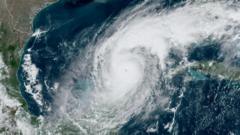The upcoming Atlantic hurricane season is predicted to be more active than usual, according to the National Oceanic and Atmospheric Administration (NOAA). Despite this forewarning, concerns are mounting as the recent staff cuts within NOAA could significantly hinder the agency's ability to track these potentially deadly storms effectively.
From June to November, NOAA anticipates that six to ten hurricanes may form in the Atlantic, slightly above the typical annual average of seven. This boost in activity is attributed to several factors, including consistently warmer sea temperatures linked to climate change and favorable atmospheric conditions.
Several meteorologists have expressed their worries about the impact of President Donald Trump's sweeping layoffs of government scientists on hurricane monitoring and forecasting. The latest projections for the 2025 hurricane season include an estimated 13 to 19 named storms, with predictions of three to five major hurricanes reaching Category 3 or higher speeds.
While this year's forecast is not as high as the previous year's active season—which had 18 named storms and five major hurricanes—NOAA's current outlook does surpass the long-term averages, increasing concerns among meteorologists regarding the accuracy of future predictions. Climate scientists note that while climate change may not increase the overall number of storms, it is expected to elevate the intensity of storms that do form.
Two primary elements contribute to the above-average season expectation: warmer sea surface temperatures in the Atlantic and the absence of the El Niño weather pattern that typically inhibits hurricane development. Instead, conditions resembling a weak La Niña are predicted, which typically favors hurricane formation.
Amid these meteorological predictions, scientists are alarmed by the workforce reductions at NOAA that have left critical positions unfilled. Reports indicate that the National Weather Service is struggling with over 150 vacancies due to a staffing freeze, with essential operational offices in regions like Texas facing significant resource constraints.
Experts are concerned that reduced personnel may compromise hurricane forecasting efforts. For example, vital "hurricane hunter" missions—aircraft flights that gather data on storm conditions—are at risk due to decreased staffing. Climate scientists fear that such cuts could impede data collection on atmospheric conditions crucial for accurate forecasting.
Experts caution that diminished data availability can lead to less reliable forecasts, which could ultimately pose risks to communities in the storm's path. The reach of these cuts could extend beyond the U.S., as global weather forecasting relies on comprehensive data from NOAA.
In response to concerns, NOAA's acting administrator reassured the public of the agency's commitment to accuracy and safety in weather forecasting, despite the upheaval from the staff reductions. As the hurricane season approaches, the implications of both climate factors and staffing levels will be crucial to monitor.
Both local residents and scientists are staying vigilant as the season unfolds, hoping the forecasts translate to accurate predictions and enhanced preparedness for potential storms.






















